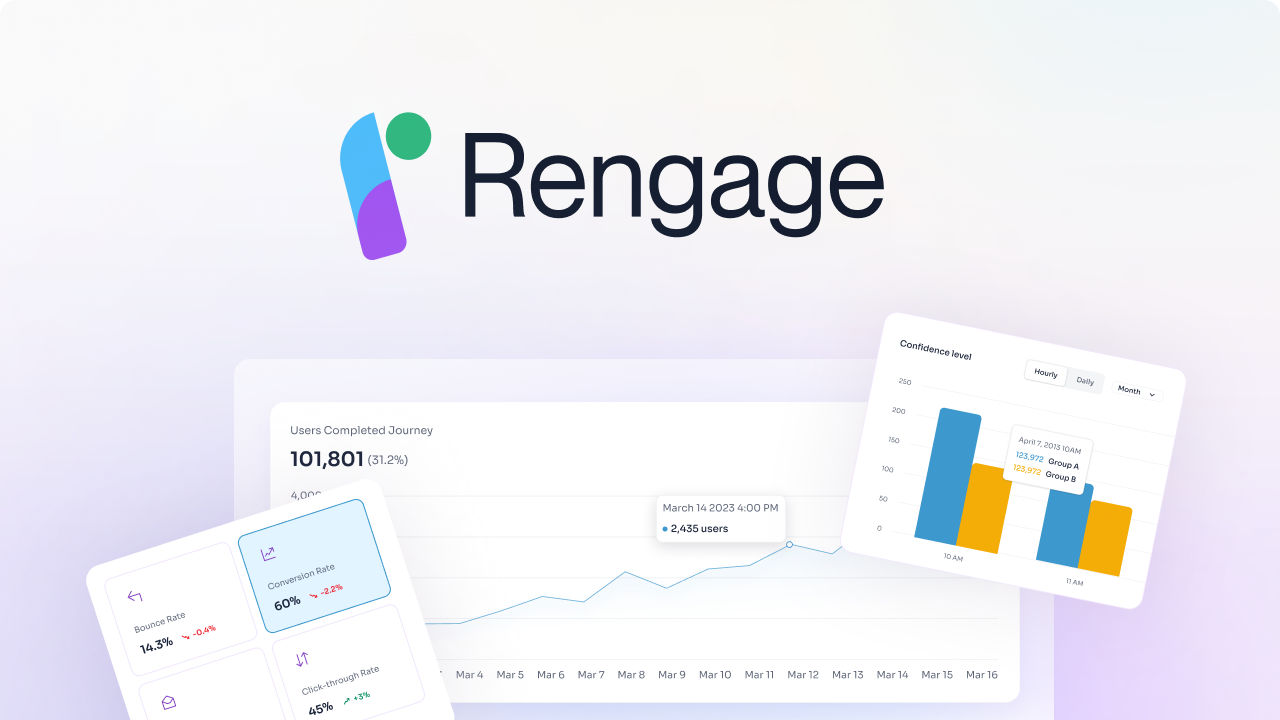Understanding customer journey insights is crucial for businesses looking to improve customer satisfaction and loyalty. By mapping and analyzing every touchpoint throughout the customer lifecycle management process, you can identify pain points, optimize processes, and enhance the overall customer experience. Through strategic analysis of customer journey insights, you can pinpoint areas where customers may be dropping off, predict future behavior, and ultimately increase retention and revenue. This blog will focus on the importance of customer journey insights and how you can leverage them to improve your business outcomes.
What Are Customer Journey Insights?

Components of a Customer Journey
The customer journey is a complex process that is influenced by several factors. It includes awareness, consideration, decision, and loyalty. Each stage of the journey is critical and plays a role in determining the success of the campaign. The journey gives better clarity about the customer's intentions and the steps they take to achieve them.
Understanding this information gives you a better opportunity to adjust your strategies to meet the customer's needs. The insight gained from the customer journey helps in creating a customer-centric marketing campaign, improved customer service, and increased customer retention rates. Understanding the different stages and their influence is key to successful marketing campaigns.
Types of Insights Gained from Customer Journeys
When analyzing customer journey maps, a company can identify potential pain points and friction points in the user journey. This allows for the pinpointing of where customers experience difficulties, helping to optimize relevant touchpoints and address customer pain points to reduce time to value and improve the overall customer experience.
Analyzing customer journey maps can improve conversion rates across different customer journeys. By identifying barriers to conversion and streamlining the journey for better conversion rates, insights gained from journey analysis can help companies increase their success rates leading to higher customer satisfaction and loyalty, ultimately impacting customer retention and lifetime value.
Importance of Customer Journey Insights for Businesses
The importance of analyzing customer journey maps is to identify opportunities to drive product and business success. They help improve customer satisfaction and retention, streamline the customer journey to improve conversion rates, and pinpoint where customers experience difficulties.
All of these benefits enable teams to optimize product messaging, marketing campaigns, in-app product experiences, and customer support processes. Understanding customer journey insights is crucial for customer success and retention.
6 Customer Journey Insights You Need for Effective Mapping

1. Goals
Every map should focus on a specific goal that your customers are looking to accomplish. Is it to book a vacation at a resort? To buy a new car? How about switching to your company from a competitor? Every journey starts with an overarching goal that drives what a customer does, thinks, and feels every step of the way. Specifying this goal before getting started is essential to keep your efforts focused.
2. Intent
What is the customer looking to accomplish at each step of the customer journey? Specific motivations drive every interaction. Confirming these motivations is essential to contextualize why customers perceive their experiences with your brand the way they do.
3. Persona insights
Who is most likely to go through this journey? Assigning personas to maps helps everyone put a face to the customers most likely to go through these journeys. Include demographic (e.g., age, gender, income) and psychographic insights (e.g., activities, personality, attitudes) to help everyone better visualize this customer.
4. Expectations
Maps should point out customers’ intent at each stage of the journey and confirm what they expect from these interactions. For example, are they expecting self-serve tools to help move to the next stage of their journey, or do they prefer to reach out to an agent (e.g., live chat, by phone) to help them accomplish certain tasks? Knowing your customers’ expectations at each touchpoint in the first place is the only way to see how you can meet or exceed those expectations.
5. Perceptions
Is your brand actually meeting customers’ expectations at each touchpoint? What do they like or dislike about their experiences? Are there any roadblocks currently jeopardizing their experiences at specific touchpoints?
The ultimate goal of mapping the customer journey is to lift these perceptions at each stage. As such, knowing how customers currently perceive their experiences today gives you a benchmark to gauge the impact of your future CX efforts (more on that in the next section).
6. Emotions
What state of mind are customers typically in when they reach this stage of their journey? Are they happy? Angry? Confused? Visualizing how a customer’s emotions may fluctuate throughout a journey can help identify where customers may require additional support options to address their frustrations and find opportunities to elevate positive experiences even further.
Transforming Customer Interactions with Rengage's Comprehensive Journey Management
We provide a comprehensive solution for managing and enhancing customer journeys, delivering insights and measurable outcomes with no code. We accelerate your customer journey from onboarding, activation to conversion and churn. Enabling customers to unlock revenue from their existing user.
With Rengage, you can get insights into your segments, run campaigns with an intuitive journey manager, and get insights to measure how your journeys impact users conversion through our Journey Moments and Journey Builder features.
- Journey Moments: insights into your micro-segments
- Journey Builder: intuitive multi-channel marketing automation
- Insights prediction and attribution.
Book a free demo to learn about how you can transform customer interactions into personalized experiences that drive loyalty and growth.
Related Reading
6 Benefits of Collecting Customer Journey Insights

1. Enhanced Decision-Making
Customer insights provide data-driven information about customer behavior, preferences, and needs, helping organizations make more informed decisions across various areas such as product development, marketing strategies, customer service improvements, and resource allocation. This leads to better targeting, improved customer experiences, and increased overall business effectiveness.
2. Improved Customer Understanding
By analyzing customer data, businesses can uncover valuable insights into customer demographics, behavior patterns, purchasing habits, and preferences. This understanding helps tailor products, services, and marketing efforts to meet specific customer needs, resulting in improved customer satisfaction, loyalty, and retention.
3. Personalized Customer Experiences
Leveraging data on customer preferences, past interactions, and purchase history allows businesses to create tailored offerings, recommendations, and targeted marketing campaigns. Personalization enhances customer engagement, builds stronger relationships, and increases the likelihood of customer conversion and long-term loyalty.
4. Increased Customer Retention and Loyalty
Customer insights enable proactive customer retention strategies by identifying churn indicators, analyzing customer sentiment, and understanding customer needs. Organizations can implement targeted retention initiatives such as personalized offers, proactive customer support, and loyalty programs. These efforts contribute to improved customer satisfaction, reduced churn rates, and increased customer loyalty.
5. Efficient Resource Allocation
Understanding customer preferences and segmenting customers allows businesses to allocate resources effectively, focusing on high-value customer segments and tailoring marketing efforts accordingly. This ensures that resources such as time, budget, and manpower are invested in areas that generate the most impact and return on investment.
6. Innovation and Product Development
By understanding customer needs, pain points, and emerging trends, organizations can develop new products, features, or services that align with customer expectations and preferences. This customer-centric approach enhances product-market fit, drives innovation, and increases the likelihood of successful product launches.
10 Data Customer Journey Insights Sources to Power Your Customer Journey Mapping

1. Online reviews
Online reviews are the most authentic source to know how your customers feel about your products and services. Use them to identify what customers perceive your brand to be doing well, what needs improvement, and what they find better in competition.
2. Competitor’s reviews
Similarly, you can also gather insights about your audience from competitors’ reviews. You can find these on the same sights above as well as groups on social media channels where there may be online communities for those product users.
3. Website data
With Google Analytics and Search Console, you can gather a wealth of insights about your customers, including:
4. Competitor website data
You of course can’t get as much detailed information from a competitor’s website, but SEO tools like Semrush and Ahrefs can give you plenty to work with.
5. Preferences & purchase activity
Your customers’ purchasing patterns give you direct visibility into which products and services are most popular—both in general and among individuals.
6. Customer surveys
Surveys have been used by businesses since the days of door-to-door marketing, but today we have online survey tools to share surveys through email, social media, in apps, and more. Surveys can be point-based, multiple choice, open-ended or any combination.
7. Customer interviews
Compared to customer surveys which are sent in a bulk fashion to several customers, customer interviews are done in a one-to-one fashion. They can be done in person, on the phone, or in a video call.
8. Success stories and case studies
Success stories, testimonials, and case studies are another form of customer interview. But whereas the above focuses on customer feedback, this one is about the story of how they used your business to solve their problem.
9. Partnerships
The digital economy has become a web where most products and services can’t exist on their own. It’s necessary to shake hands, or in tech terms, integrate seamlessly, with other services and applications.
10. Social media
People don’t hold back from showering praise or complaints on social media, making it a great place to gather customer insights. You can monitor comments and posts to keep an ear out, but you can also openly ask for feedback through posts and polls.
14 Best Tools for Effective Customer Journey Insights Collection
1. Rengage: Comprehensive Solution for Customer Journeys

Rengage provides a comprehensive solution for managing and enhancing customer journeys, delivering insights and measurable outcomes with no code. The platform accelerates customer journeys from onboarding to conversion and churn. With Rengage, users can get insights into their segments, run campaigns with an intuitive journey manager, and measure how journeys impact user conversion through features like Journey Moments and Journey Builder.
The platform also offers features like insights prediction and attribution, making it a suitable tool for transforming customer interactions into personalized experiences that drive loyalty and growth.
2. Userpilot: Digital Adoption Platform
Userpilot is a digital adoption platform that allows users to analyze journeys inside an app, collect feedback, and act on insights by creating interactive in-app experiences. Its analytics features include user segmentation, feature and event tagging, heatmaps, funnel analysis, path analysis, trend and retention analysis, flow analytics, A/B and multivariate testing, and integrations with tools like Google Analytics, Amplitude, Mixpanel, and Heap.
3. Google Analytics: Free Analytics Platform
Google Analytics is a free analytics platform that tracks and analyzes user interactions throughout customer journeys, mainly for web analytics. It supports funnel and path analysis (explorations) to optimize website flow for conversions. The tool also offers insights into traffic sources for effective resource allocation, demographic reports for customer insights, and integrations with tools like Google Adsense for tracking PPC campaign performance.
4. Amplitude: Dedicated Analytics Platform
Amplitude is a dedicated analytics platform with capabilities like segmentation, funnel and user journey analysis, conversion drivers, cohort analysis, root cause analysis, campaign reporting, and cart analysis. Users can track behavior on websites and apps but require a third-party tool for engagement to act on customer journey insights effectively.
5. Hotjar: Granular Customer Experience Insights
Hotjar's product experience insights tools offer granular customer experience insights through quantitative and qualitative data analysis. Features like session replays, heatmaps, exit-intent surveys, and integrations with other tools provide comprehensive data analysis. Hotjar enables businesses to visualize customer journeys, identify issues, optimize touchpoints, enhance conversion rates, facilitate team communication, and support cross-functional collaboration.
6. Zonka Feedback: Survey and Feedback Collection
Zonka Feedback offers ready-to-use survey templates, multiple question types, data collection forms, and online channels for capturing customer feedback. The platform enables businesses to collect qualitative and quantitative data, analyze feedback, and make data-driven decisions. It is ideal for businesses looking to gather customer insights through surveys and data collection methods, especially with large customer bases.
7. Mixpanel: Customer Journey Mapping and Analysis
Mixpanel features capabilities like customer journey mapping, segmentation, retention, loyalty improvement, and personalization. The platform helps businesses create complete customer journey maps, identify pain points, and optimize the customer experience. Mixpanel is suitable for businesses aiming to improve customer retention and loyalty by analyzing behaviors and optimizing customer journeys.
8. SurveyMonkey: Customer Feedback Collection
SurveyMonkey offers ready-to-use survey templates, various question types, and data analysis features for gathering customer feedback. The platform enables businesses to gather insights through surveys, analyze results, and make data-driven decisions. SurveyMonkey is valuable for businesses aiming to gather feedback, especially with small to medium-sized customer bases.
9. Falcum: Customer Data Collection and Analysis
Falcum provides data collection and analysis capabilities, including survey and feedback tools. The platform helps businesses gather and analyze customer data, identify trends, and make data-driven decisions. It is recommended for businesses aiming to gather and analyze customer data, especially with large customer bases or complex customer journeys.
Related Reading
- Digital Customer Journey Mapping
- Customer Journey Analysis
- Ecommerce Customer Journey
- B2B Customer Journey
- Customer Journey Orchestration
- Omnichannel Customer Journey
- Saas Customer Journey
- Marketing Automation Customer Journey
- Customer Journey Optimization
- Micro Moments Customer Journey
- Customer Journey Research
- Customer Journey Automation
- Customer Journey Dashboard
- Customer Journey Personalization
- Customer Journey Metrics
- Customer Journey Best Practices
7 Common Challenges With Customer Journey Insights

Challenges in Data Quality and Integration
Ensuring data quality and integrating data from multiple sources are major challenges in our field. Incomplete, inaccurate, or inconsistent data can hinder the generation of reliable customer insights. Data teams need to address data quality issues, perform data cleansing, and establish robust data integration processes to ensure a unified and accurate view of customer data.
Privacy and Security Concerns
Protecting customer data and complying with privacy regulations (such as GDPR or CCPA) is a critical challenge. Data teams must implement robust data privacy and security measures to safeguard customer information and ensure compliance. Balancing the need for data access with privacy concerns can be complex and requires thorough data governance practices.
Fragmented Views of Audience
Customer data often resides in various systems or departments within an organization, leading to data silos and fragmentation. Data teams need to overcome these silos and consolidate data from different sources to gain a holistic view of customers. Often, a simple solution is unifying data on a single, open enterprise data platform such as a data lakehouse.
Lack of Data Expertise and Skills
Extracting valuable insights from customer data requires a skilled data team. A shortage of data expertise or inadequate data skills can pose a challenge. Data teams need to have the necessary skills in data analysis, statistical modeling, machine learning, and data visualization to effectively interpret and communicate customer insights across stakeholders.
Legacy Technology Challenges
The availability and effectiveness of technology infrastructure and tools can impact the ability to collect, analyze and activate customer insights. Outdated or inadequate tools may limit the efficiency and scalability of data processes. Data teams should continuously assess and invest in robust technologies to support their customer insights initiatives.
Stakeholder Alignment and Collaboration
Collaborating with various stakeholders within the organization is essential for successful customer insights activation. Data teams often face challenges in aligning with business units, marketing teams, or executive leadership to drive the adoption of insights and translate them into actionable strategies. Building strong relationships, implementing effective communication, and demonstrating the value of customer insights are key to fostering collaboration.
Data Overload and Analysis Paralysis
With the abundance of data available, data teams may face challenges in dealing with data overload and analysis paralysis. It can be overwhelming to extract meaningful insights from vast amounts of data. Prioritizing relevant data, defining clear objectives, and leveraging advanced analytics techniques can help data teams overcome this challenge.
Related Reading
- Customer Lifecycle Management Software
- Customer Journey Mapping Tools
- Customer Journey Management
- Braze Alternative
- Fullstory Alternatives
- Adobe Analytics Alternatives
- Customer Journey Analytics Tools
- Iterable Competitors
- Marketo Alternatives
- Onesignal Alternatives
- Clevertap Alternatives
- Bloomreach Alternatives
- Customer.io Alternatives
4 Best Practices for Effective Customer Journey Insights Collection & Application

Establishing a customer-centric culture
Foster a customer-centric culture across the organization. Encourage all teams to prioritize customer insights and data-driven decision-making. This includes promoting a mindset of continuous learning, valuing customer feedback and making customer-centricity a core part of the organizational values. By embedding a customer-focused culture, employees are more likely to embrace customer insights and act upon them.
Aligning insights with business objectives
Ensure that customer insights align with the organization’s broader business objectives. Clearly define the strategic goals and objectives of the organization and identify how customer insights can contribute to achieving them. This alignment helps prioritize insights that are most relevant to the business and ensures that the insights drive actionable outcomes. Regularly revisit and reassess the alignment between insights and business objectives to stay agile and adaptable.
Breaking down data silos and fostering collaboration
Encourage cross-functional collaboration and break down data silos within the organization. Promote information sharing, collaboration and communication among teams to leverage customer insights effectively. Data teams should work closely with marketing, sales, product development and customer service teams to share insights, align strategies and jointly execute initiatives. Foster a culture of collaboration and provide platforms or tools that facilitate knowledge sharing and collaboration.
Continuously measuring, evaluating and iterating
Implement a process of continuous measurement, evaluation and iteration to refine the use of customer insights. Regularly monitor the impact of insights-driven initiatives, track key performance indicators (KPIs), and evaluate the effectiveness of strategies and actions taken based on insights. Use feedback loops and data-driven insights to inform decision-making and refine approaches over time. Encourage a culture of experimentation and learning from both successes and failures.
Create Personalized Experiences That Drive Loyalty and Growth with Rengage — Book A Free Demo Today
Rengage is a powerful tool that empowers businesses to take a deep dive into their customer journey insights. By leveraging the capabilities of Rengage, businesses can understand their customers' behavior, preferences, and needs at each touchpoint of the journey. With the Journey Moments feature, businesses can gain valuable insights into micro-segments within their customer base. This allows for more targeted and personalized marketing campaigns, leading to higher conversion rates and improved customer retention.
Empowering Marketing Automation with Journey Builder
The Journey Builder feature brings automation to the next level, enabling businesses to create and deploy multi-channel marketing campaigns seamlessly. By automating the customer journey, businesses can ensure that the right message reaches the right customer at the right time, driving engagement and conversions.
Unlocking Insights with Prediction and Attribution
Rengage provides prediction and attribution insights, allowing businesses to measure the impact of their customer journeys on user conversion. By understanding which touchpoints are most effective in driving conversions, businesses can optimize their customer journey strategy to maximize results.
Transforming Customer Interactions with Rengage
Rengage is a comprehensive solution for managing and enhancing customer journeys, delivering valuable insights and measurable outcomes with ease. With no code required, businesses can accelerate their customer journey from onboarding to churn, unlocking revenue from their existing user base. If you're looking to transform customer interactions into personalized experiences that drive loyalty and growth, Rengage is the tool for you.
Book a free demo today to learn more about how Rengage can take your customer journey insights to the next level.
